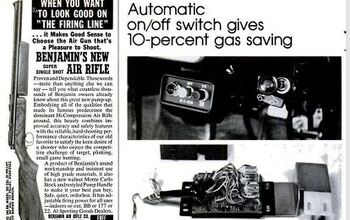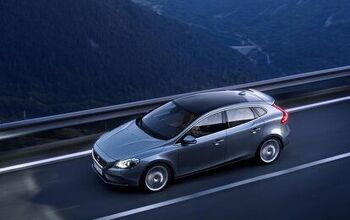The Problem With Start-Stop Systems
For an industry under ever-increasing pressure from government emissions standards, start-stop technology (which shuts off engines under idling conditions) seems like an easy route to improved fuel efficiency. Cheaper and less complicated than a true hybrid system, a number of automakers from BMW to Kia are proliferating start-stop technology across their product lines without hybrid-like price premium. Since this technology represents a relatively easy, incremental efficiency upgrade, we’ve wondered why it hasn’t been made available stateside, where hybrids are making up a growing proportion of sales. Detroit’s executives seem to think it’s a good idea, and Mazda has even gone so far as to complain that EPA test results refusing to show the Japanese test-cycle’s 7-9 percent improvement is the main factor preventing it from bringing more stop-start equipped vehicles to the US. But there’s another issue preventing stop-start from becoming standard issue industry-wide, and it’s actually remarkably obvious.
Of course, the start-stop systems have smarter computers than that, which is why the systems rarely activated in AM und S’s test. And ironically, the three vehicles equipped with the system actually logged the top CO2 emission results in the test despite the recalcitrance of their technological advantages. Still, just as cold-weather performance remains a huge question mark in the development of electric vehicles, living in a cold climate could seriously limit the advantages of this seemingly inevitable efficiency-boosting gizmo.
More by Edward Niedermeyer
Latest Car Reviews
Read moreLatest Product Reviews
Read moreRecent Comments
- Kjhkjlhkjhkljh kljhjkhjklhkjh A prelude is a bad idea. There is already Acura with all the weird sport trims. This will not make back it's R&D money.
- Analoggrotto I don't see a red car here, how blazing stupid are you people?
- Redapple2 Love the wheels
- Redapple2 Good luck to them. They used to make great cars. 510. 240Z, Sentra SE-R. Maxima. Frontier.
- Joe65688619 Under Ghosn they went through the same short-term bottom-line thinking that GM did in the 80s/90s, and they have not recovered say, to their heyday in the 50s and 60s in terms of market share and innovation. Poor design decisions (a CVT in their front-wheel drive "4-Door Sports Car", model overlap in a poorly performing segment (they never needed the Altima AND the Maxima...what they needed was one vehicle with different drivetrain, including hybrid, to compete with the Accord/Camry, and decontenting their vehicles: My 2012 QX56 (I know, not a Nissan, but the same holds for the Armada) had power rear windows in the cargo area that could vent, a glass hatch on the back door that could be opened separate from the whole liftgate (in such a tall vehicle, kinda essential if you have it in a garage and want to load the trunk without having to open the garage door to make room for the lift gate), a nice driver's side folding armrest, and a few other quality-of-life details absent from my 2018 QX80. In a competitive market this attention to detai is can be the differentiator that sell cars. Now they are caught in the middle of the market, competing more with Hyundai and Kia and selling discounted vehicles near the same price points, but losing money on them. They invested also invested a lot in niche platforms. The Leaf was one of the first full EVs, but never really evolved. They misjudged the market - luxury EVs are selling, small budget models not so much. Variable compression engines offering little in terms of real-world power or tech, let a lot of complexity that is leading to higher failure rates. Aside from the Z and GT-R (low volume models), not much forced induction (whether your a fan or not, look at what Honda did with the CR-V and Acura RDX - same chassis, slap a turbo on it, make it nicer inside, and now you can sell it as a semi-premium brand with higher markup). That said, I do believe they retain the technical and engineering capability to do far better. About time management realized they need to make smarter investments and understand their markets better.


































Comments
Join the conversation
** BREAKING NEWS ** Automobiles have higher energy requirements when it's cold outside. Shocking stuff. You sit in a traffic jam on a warm day and then try and make an argument that S&S doesn't make sense. Easy to use, easy to implement, good sense all round. As a design objective: - make a vehicle use as high a proportion as possible of the fuel consumed to create forward motion - ...you'd have built S&S in from the beginning.
Regarding Start & Stop systems: I'm not sure if this is related to S-S technology but since it involves the first vehicle I purchased having this system I have my suspicions. It's either just a battery/electrical system issue or it's related to the battery/electrical system in support of S-S. I purchased a 2013 BMW model X3 SUV in Aug. 2012. The S-S system works fine (instant, effortless, & quiet) but I've had some major battery discharging problems beginning in Oct. 2013. I was quite puzzled considering how much the vehicle cost and the fact that it was only a little over a year old. I charged the battery back up to 100%. Then in Dec. another low battery warning. Another re-charge. Another warning in Jan. By this time I'm getting pretty frustrated that I've had to re-charge the battery three times in four months. I scheduled an appointment with the dealership service dep't. They had to replace the battery, battery cable, and battery sensory cable. Wanting to find out what this was all about I contacted four different people: The salesman, a service tech, the service dep't. manager, and the BMW North American Customer Service Dep't. rep. It was obvious at the onset that they weren't open to any discussion dealing with the issue. When I first inquired I got the impression that none of them knew what the problem was (or maybe just didn't want to talk about it). Initially I got varying responses ranging from the too much computer technology for the electrical system to support to it being related to cold weather. After pressuring them further they finally stated that it was an inherent problem with BMW vehicles in colder states. It's bad enough that I have to suffer with sub zero temps here in Minnesota - now I'm being penalized with the vehicle I drive (lol). But the real kicker was when I went to pick up the vehicle. The service manager told me that I should get a battery charger and expect to have to re-charge the battery every once in awhile. Also that if the warning light came on while out driving, I should make sure and drive for a least a couple of hours so the alternator could re-charge the battery (just when I thought I was going to save money on a fuel efficient vehicle). I responded by telling him that if the salesman had been honest and told me of this issue I probably wouldn't have purchased a vehicle with S-S technology. During my discussion with the national customer service (now there's a contradiction of terms) rep I inquired if BMW would be willing to re-purchase. I was told that for this to happen the dealership service dep't. would have to declare that it was a defective vehicle. I guess I can expect that to happen when it gets really hot here in Minnesota in January. I'm not as upset with the engineering flaw on the part of BMW as I am with the way their staff handled it.